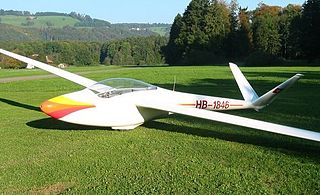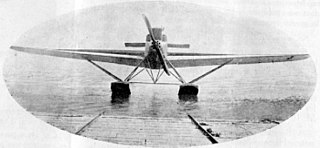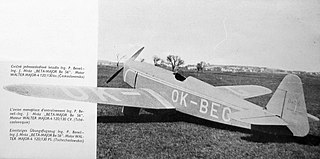| V 58 | |
|---|---|
 | |
| Role | Light sport aircraft |
| National origin | Germany |
| Manufacturer | LFG |
| First flight | 1926 |
| Status | prototype only |
| Number built | 1 |
The LFG V 58 was a light sport aircraft built in Germany in the late 1920s.
| V 58 | |
|---|---|
 | |
| Role | Light sport aircraft |
| National origin | Germany |
| Manufacturer | LFG |
| First flight | 1926 |
| Status | prototype only |
| Number built | 1 |
The LFG V 58 was a light sport aircraft built in Germany in the late 1920s.
Data from [1]
General characteristics
Performance

The Aermacchi M-290 TP RediGO is a turboprop-powered military basic trainer aircraft and liaison aircraft. It was originally manufactured by Valmet of Finland as the L-90 TP Redigo, a development of their earlier training aircraft for the Finnish Air Force. The L-90 was the last military aircraft designed and produced in Finland.

The H-101 Salto is an aerobatic glider of glass composite construction, developed in Germany in the 1970s. Based on the Standard Libelle H-201, it was designed by Ursula Hänle, widow of Eugen Hänle, former Director of Glasflügel. It was first produced by Start + Flug GmbH Saulgau.
Valmet L-80 TP Turbo-Vinha was a prototype for a new Finnish turboprop basic trainer aircraft. The aircraft, which carried the designation OH-VBB, was destroyed in a crash in 1985, killing the test pilot Paavo Janhunen. The aircraft was a further development of the Valmet L-70 Vinka and would eventually lead to the Valmet L-90 Redigo.

The Agusta A.101 was a large prototype transport helicopter developed in Italy during the 1960s. Despite prospective orders from the Italian armed forces, no buyers emerged and the project was abandoned in 1971.

The SZD-59 Acro is a single-seat glass composite glider for aerobatics and cross-country flying by PZL Allstar of Bielsko-Biala, Poland.

The LFG Roland D.III was a fighter aircraft produced in Germany during World War I.

The LFG V 13 Strela was a seaplane airliner produced in small quantities in Germany in the early 1920s. It was a conventional, three-bay biplane with an enclosed cabin for four passengers. The original design featured twin pontoons, but a landplane version was developed as the V 130.

The LFG V 20 Arkona was a seaplane airliner produced in small quantities in Germany in the early 1920s. It was a conventional, strut-braced, low-wing monoplane with an enclosed cabin for four passengers. The undercarriage consisted of twin pontoons. Originally produced in wood, a metal version of the aircraft was also developed
The LFG V 101 Jasmund was a seaplane airliner produced in small quantities in Germany in the 1920s. It was a conventional, strut-braced, low-wing monoplane with an enclosed cabin for five passengers, an enlarged, metal development of the V 20 Arkona.

The Horten H.III was a flying wing sailplane built by Walter and Reimar Horten in Germany from 1937 to 1944.
The Air Est JCD 03 Pelican is a French mid-wing, twin tailed, flying wing single-seat motor glider that was designed by Jean-Claude Debreyer and produced by Air Est Services of Marly, Moselle and supplied as a kit for amateur construction or as a complete aircraft.
The Aerola Alatus is a Ukrainian mid-wing, single-seat, glider and motor glider, designed and produced by Aerola of Kiev.
The V 42 was a one off, single-engine, two-seat sports monoplane, built in Germany in 1925.

The LFG V 60 was a small, single engine, tandem seat floatplane training aircraft, designed and built in Germany in the mid-1920s. About five were constructed.

The Culp Special is an American aerobatic homebuilt aircraft designed and produced by Culp's Specialties of Shreveport, Louisiana. The aircraft is supplied as a kit or in the form of plans for amateur construction.
The NWT Spruce Coupe is an American homebuilt aircraft that was designed and produced by NWT Co of Charleston, Maine. When it was available the aircraft was supplied as a kit and also in the form of plans for amateur construction.
The LFG Roland C.VIII was a German reconnaissance aircraft of World War I. It was manufactured by Luft-Fahrzeug-Gesellschaft G.m.b.H.
The Caspar CS 14 was a German fighter aircraft built in the 1920s.

The Beneš-Mráz Be-56 Beta-Major was a single-seat aerobatic advanced trainer manufactured in Czechoslovakia shortly before World War II.

The Lommatzsch Libelle or VBAL Libelle was an advanced, high performance training glider built in the GDR in the 1950s. There were several variants and over 100 were built.
| Wikimedia Commons has media related to LFG V 58 . |